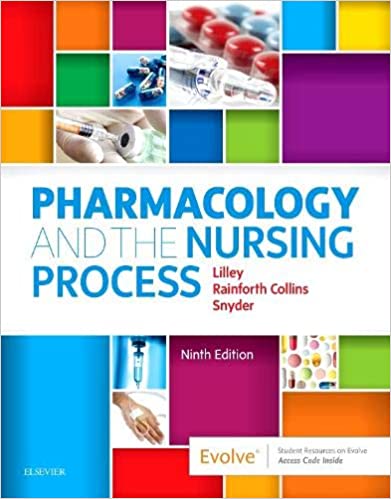Pharmacology And The Nursing Process 9th Edition Lilley Test Bank
Original price was: $80.00.$14.50Current price is: $14.50.
Pharmacology And The Nursing Process 9th Edition Lilley Test Bank is a great resource for nurses. It provides a comprehensive overview of pharmacology and the nursing process. The book is divided into four parts: Pharmacokinetics, Pharmacodynamics, Pharmacotherapeutics, and Pharmacotherapy.
Each section provides detailed information on the various drugs used to treat different conditions. In addition, the book includes a variety of practice questions and answers to ensure that nurses have a solid understanding of the material. Pharmacology And The Nursing Process 9th Edition Lilley Test Bank is an essential resource for any nurse looking to expand their knowledge of pharmacology.
Digital item No Waiting Time Instant Download
Chapters: 58
Format: PDF
ISBN-13: 978-0323529495
ISBN-10: 0323529496
Publisher: Mosby
Authors: Linda Lane Lilley,
Shelly Rainforth Collins PharmD, Julie S. Snyder
Description
Test bank Pharmacology and the Nursing Process 9th Edition Lilley Collins Snyder
pharmacology and the nursing process 9th edition Quizlet
ISBN 9780323529495 test bank
- ISBN-10 : 0323529496
- ISBN-13 : 978-0323529495
- Authors: Lilley, Collins, Snyder
PART 1: PHARMACOLOGY BASICS
1. The Nursing Process and Drug Therapy
2. Pharmacologic Principles
3. Lifespan Considerations
4. Cultural, Legal, and Ethical Considerations
5. Medication Errors: Preventing and Responding
6. Patient Education and Drug Therapy
7. Over-the-Counter Drugs and Herbal and Dietary Supplements
8. Gene Therapy and Pharmacogenomics
9. Photo Atlas of Drug Administration
PART 2: DRUGS AFFECTING THE CENTRAL NERVOUS SYSTEM
10. Analgesic Drugs
11. General and Local Anesthetics
12. Central Nervous System Depressants and Muscle Relaxants
13. Central Nervous System Stimulants and Related Drugs
14. Antiepileptic Drugs
15. Antiparkinson Drugs
16. Psychotherapeutic Drugs
17. Substance Use Disorder
PART 3: DRUGS AFFECTING THE AUTONOMIC NERVOUS SYSTEM
18. Adrenergic Drugs
19. Adrenergic-Blocking Drugs
20. Cholinergic Drugs
21. Cholinergic-Blocking Drugs
PART 4: DRUGS AFFECTING THE CARDIOVASCULAR AND RENAL SYSTEMS
22. Antihypertensive Drugs
23. Antianginal Drugs
24. Heart Failure Drugs
25. Antidysrhythmic Drugs
26. Coagulation Modifier Drugs
27. Antilipemic Drugs
28. Diuretic Drugs
29. Fluids and Electrolytes
PART 5: DRUGS AFFECTING THE ENDOCRINE AND REPRODUCTIVE SYSTEMS
30. Pituitary Drugs
31. Thyroid and Antithyroid Drugs
32. Antidiabetic Drugs
33. Adrenal Drugs
34. Women’s Health Drugs
35. Men’s Health Drugs
PART 6: DRUGS AFFECTING THE RESPIRATORY SYSTEM
36. Antihistamines, Decongestants, Antitussives, and Expectorants
37. Respiratory Drugs
PART 7: ANTIINFECTIVE AND ANTIINFLAMMATORY DRUGS
38. Antibiotics Part 1
39. Antibiotics Part 2
40. Antiviral Drugs
41. Antitubercular Drugs
42. Antifungal Drugs
43. Antimalarial, Antiprotozoal, and Anthelmintic Drugs
44. Antiinflammatory and Antigout Drugs
PART 8: CHEMOTHERAPEUTIC DRUGS AND BIOLOGIC AND IMMUNE MODIFIERS
45. Antineoplastic Drugs Part 1: Cancer Overview and Cell Cycle–Specific Drugs
46. Antineoplastic Drugs Part 2: Cell Cycle–Nonspecific Drugs and Miscellaneous Drugs
47. Biologic Response–Modifying and Antirheumatic Drugs
48. Immunosuppressant Drugs
49. Immunizing Drugs
PART 9: DRUGS AFFECTING THE GASTROINTESTINAL SYSTEM AND NUTRITION
50. Acid-Controlling Drugs
51. Bowel Disorder Drugs
52. Antiemetic and Antinausea Drugs
53. Vitamins and Minerals
54. Anemia Drugs
55. Nutritional Supplements
PART 10: DERMATOLOGIC, OPHTHALMIC, AND OTIC DRUGS
56. Dermatologic Drugs
57. Ophthalmic Drugs
58. Otic Drugs
Chapter 01: The Nursing Process and Drug Therapy
MULTIPLE CHOICE
1. The nurse is writing a nursing diagnosis for a plan of care for a patient who has been newly
diagnosed with type 2 diabetes. Which statement reflects the correct format for a nursing
diagnosis?
a. Anxiety
b. Anxiety related to new drug therapy
c. Anxiety related to anxious feelings about drug therapy, as evidenced by statements
such as “I’m upset about having to test my blood sugars.”
d. Anxiety related to new drug therapy, as evidenced by statements such as “I’m
upset about having to test my blood sugars.”
ANS: D
Formulation of nursing diagnoses is usually a three-step process. “Anxiety” is missing the
“related to” and “as evidenced by” portions of defining characteristics. “Anxiety related to new
drug therapy” is missing the “as evidenced by” portion of defining characteristics. The statement
beginning “Anxiety related to anxious feelings” is incorrect because the “related to” section is
simply a restatement of the problem “anxiety,” not a separate factor related to the response.
DIF: COGNITIVE LEVEL: Understanding (Comprehension)
TOP: NURSING PROCESS: Nursing DiaBtestbanks.com
MSC: NCLEX: Safe and Effective Care Environment: Management of Care
2. The patient is to receive oral guaifenesin (Mucinex) twice a day. Today, the nurse was busy and
gave the medication 2 hours after the scheduled dose was due. What type of problem does this
represent?
a. “Right time”
b. “Right dose”
c. “Right route”
d. “Right medication”
ANS: A
“Right time” is correct because the medication was given more than 30 minutes after the
scheduled dose was due. “Dose” is incorrect because the dose is not related to the time the
medication administration is scheduled. “Route” is incorrect because the route is not affected.
“Medication” is incorrect because the medication ordered will not change.
DIF: COGNITIVE LEVEL: Applying (Application)
TOP: NURSING PROCESS: Implementation
MSC: NCLEX: Safe and Effective Care Environment: Safety and Infection Control
3. The nurse has been monitoring the patient’s progress on a new drug regimen since the first dose
and documenting the patient’s therapeutic response to the medication. Which phase of the
nursing process do these actions illustrate?
a. Nursing diagnosis





Be the first to review “Pharmacology And The Nursing Process 9th Edition Lilley Test Bank”